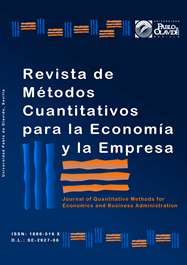Productivity Shocks Diffusion in Firms Networks with Imperfect Competition and Bankruptcy
DOI:
https://doi.org/10.46661/revmetodoscuanteconempresa.4715Keywords:
productive networks, imperfect competition, firms bankruptcy, equilibriumAbstract
The productive network represents a key economic mechanism to understand how microeconomic shocks spread in the economic system. At this scope, several theoretical works have been developed under the assumption of free competition, without considering market power or the possible bankruptcy of firms. This document studies the diffusion of productivity shocks in productive networks with imperfect competition and firms’ bankruptcy. It is assumed that firms can to set the price of their product, taking into account that prices affect the possibility of their buyers hiring them. This fact means that transactions could fail because, for instance, the products do not have the expected quality or characteristics, which would generate losses for the buyer. In this context, the buyer seeks not only the highest expected benefit, but also the lowest risk of loss, which leads him to assign a hiring probability to each supplier. On the other hand, firms’ bankruptcy is represented by a stochastic process in which firms with worse performance over time are more likely to leave the industry. The model’s results show different cascade effects on prices and quantities exchanged in the production network to negative productivity shocks. Interestingly, we observe an upstream cascade effect on firm bankruptcy over time, which is transmitted exclusively to suppliers with the lowest risk in the production network.
Downloads
References
Acemoglu, D., Carvalho, Vasco, M., Ozdaglar, A., & Tahbaz-Salehi., A. (2012). The Network Origins of Aggregate Fluctuations. Econometrica, 80(5), 1977-2016. https://doi.org/10.3982/ECTA9623
Acemoglu, D., Ozdaglar, A., & Tahbaz-Salehi, A. (2016). Networks, Shocks, and Systemic Risk. The Oxford Handbook of the Economics of Networks, January, 569-607. https://doi.org/10.3386/w20931
Acemoglu, D., Ozdaglar, A., & Tahbaz-Salehi, A. (2017). Microeconomic Origins of Macroeconomic Tail Risks. American Economic Review, 107(1), 54-108. https://doi.org/10.1257/aer.20151086
Atalay, E. (2017). How Important Are Sectoral Shocks? American Economic Journal: Macroeconomics, 9(4), 254-280. https://doi.org/10.1257/mac.20160353
Baqaee, D.R. (2018). Cascading Failures in Production Networks. Econometrica, 86(5), 1819-1838. https://doi.org/10.3982/ECTA15280
Carvalho, V.M. (2010). Aggregate Fluctuations and the Network Structure of Intersectoral Trade. In Economics Working Papers 1206. http://www.econ.ucdavis.edu/seminars/papers/337/3371.pdf
Carvalho, V. M., & Gabaix, X. (2013). The Great Diversification and its Undoing. American Economic Review, 103(5), 1697-1727. https://doi.org/10.1257/aer.103.5.1697
Grassi, B. (2017). IO in I-O: Size, Industrial Organization, and the Input-Output Network Make a Firm Structurally Important. Working Paper.
Stella, A. (2015). Firm dynamics and the origins of aggregate fluctuations. Journal of Economic Dynamics and Control, 55(1133), 71-88. https://doi.org/10.1016/j.jedc.2015.03.009
Downloads
Published
How to Cite
Issue
Section
License

This work is licensed under a Creative Commons Attribution-ShareAlike 4.0 International License.
Submission of manuscripts implies that the work described has not been published before (except in the form of an abstract or as part of thesis), that it is not under consideration for publication elsewhere and that, in case of acceptance, the authors agree to automatic transfer of the copyright to the Journal for its publication and dissemination. Authors retain the authors' right to use and share the article according to a personal or instutional use or scholarly sharing purposes; in addition, they retain patent, trademark and other intellectual property rights (including research data).
All the articles are published in the Journal under the Creative Commons license CC-BY-SA (Attribution-ShareAlike). It is allowed a commercial use of the work (always including the author attribution) and other derivative works, which must be released under the same license as the original work.
Up to Volume 21, this Journal has been licensing the articles under the Creative Commons license CC-BY-SA 3.0 ES. Starting from Volume 22, the Creative Commons license CC-BY-SA 4.0 is used.










